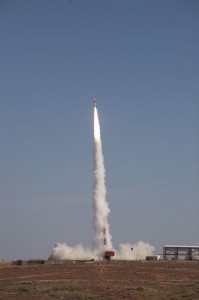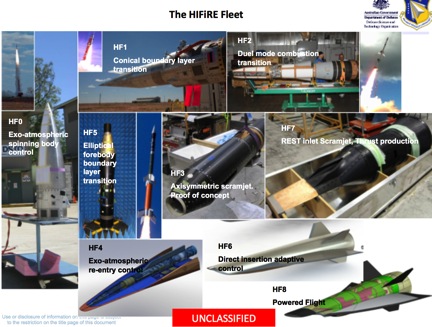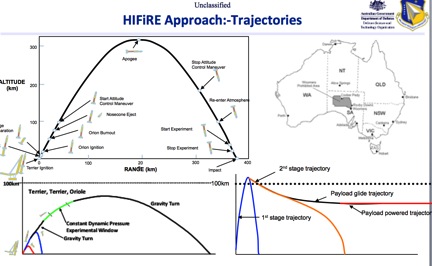2014-04-04 Second Line of Defense recently visited Australia and talked with a number of Australian military and scientists about the evolving approach to shaping capabilities for the defense of Australia and the emergence of a new allied approach to Pacific defense.
The new tanker and Wedgetail are certainly part of the effort, as well as the coming of the F-35 to Australia as part of a broader F-35 Pacific fleet, both US and allied. But a less visible element is hypersonics and the potential for the weapons revolution.
As we know from our time with Dr. Mark Lewis, the longest-serving Chief Scientist in Air Force history and now head of IDA’s Science and Technology Policy Institute, which supports the White House Office of Science & Technology Policy and the National Science Foundation, that hypersonics will be a game changer.

In the words of Lewis in an SLD interview:
Modern warfare is about doing things quickly. It’s about achieving fast effects, getting results quickly. If you want to affect something quickly, I can think of basically three options.
The first option is that you have ubiquitous presence. That means you’ve got an asset anywhere you need it. That asset might be unmanned, and frankly, that’s a lot of what remotely piloted aircraft are enabling for us – having small assets available and re-locatable at a moment’s notice. Of course, ubiquitous presence is only good in a limited area; we obviously can’t have ubiquitous presence at every location around the globe, but that’s one part of the solution that is already changing warfare.
The second option for doing things quickly is to operate at the speed of light. For my aerodynamics friends, the speed of light is about a million times faster than the speed of sound. Operating at light speed means using directed energy systems and/or cyber systems, which are among the other things that Mr. Wynne championed when he was Secretary of the Air Force. And of course, there’s a lot of development underway right now in directed energy systems, and lots of corresponding questions about how we ultimately would deploy them, as well as how we would ultimately use cyber systems.
If you don’t have the first two available, or if they cannot deliver the desired result, a third option is that you get to where you want to go as fast as you possibly can. That’s the advantage of hypersonics. This could be to perform reconnaissance of some sort, do some sensing, or to deliver weapons on a target. In order to do that, we need to master the technology required to fly at hypersonic speeds.
Hypersonics would also give us a degree of invulnerability. We know that the application of stealth technologies has been a tremendous game-changer, but that stealth advantage won’t last forever. I would argue that the next step beyond stealth is speed.
With the emergence of the second nuclear age, and competitors shaping extended reach for their missiles in their forces in the Pacific, even a continent “down under” is part of the 21t century defense challenge. Clearly, some Aussies get this, and see hypersonics as part of that challenge and an opportunity as well.
The recent Chinese tests reminded folks that this is a highly competitive world, and a dedicated effort to roll out hypersonic capabilities (with Russia, India, China and the US clearly in the mix) will be part of the future of warfare, whether one wants it or not.
Australia has a small but cutting edge team of hypersonic researchers, and with the test ranges to play out the evolving technologies, and with significant global working relationships, Australia is at the cutting edge of hypersonic research.
Research can clearly yield possible capabilities for space as well, with an ability to launch rapidly ISR and C2 capabilities for Australia and as part of the effort to overcome the tyranny of distance to deal with longer range threats and challenges as well.
SLD had a chance to sit down with a team of Australian hypersonics researchers to discuss the Aussie hypersonic effort and its progress.
The effort was discussed with Dr. Allan Paull and members of the hypersonics team close to Brisbane. Dr. Paull made it clear that the team was small but effective.
“We combine the skills of several disciplines but each member of the team takes ownership of the entire effort and provides inputs to each and every aspect of the enterprise. We are not organized around a model of deep pocket experts who stay within the confines of their specialty; we interact across the enterprise to push the research effort forward.”
Dr. Paull emphasized that the hypersonic effort required progress in several technologies at the same time, materials, propulsion, computation, etc.
Visiting the workroom of the DSTO where two hypersonic vehicles are being worked on certainly reinforced the point that several moving parts are being worked toward the next hypersonic test point.
The key takeaway from the discussion with Dr. Paull was rather straightforward:
“By 2015 we will have finished our current round of tests, and by that time there is little question but that the basic scamjet technology works and can be leveraged moving forward.”
Australia has worked with the USAF in building out a HiFire set of test vehicles.
The objectives of the program are two fold:
- To develop the science and technology for hypersonic flight with air breathing propulsion;
- Complete a horizontal flight of a scramjet-powered vehicle for a duration of 30 seconds.
An interesting aspect of the Aussie effort has been to build an engine, which can reach hypersonic speeds but fits into the center of a vehicle.
The team is working a number of innovations to achieve this result. Such an engine if proven out would be a major step forward in making practical use of scamjet technology.
The HiFire uses a high angle of attack profile as well which adds a potential of maneuverability to speed.
Much has been achieved by Australia working with its partners in hypersonic research in less than a decade. But the importance of this effort, and the need to be on the cutting edge is clear.
The timetable followed to date can be seen below:
http://www.youtube.com/watch?v=snAmVqc99CE
For an overview on hypersonic research in Australia which summed up progress towards the end of the last decade and published by NATO see the following:
http://ftp.rta.nato.int/public/PubFullText/RTO/EN/RTO-EN-AVT-150/EN-AVT-150-11.pdf




